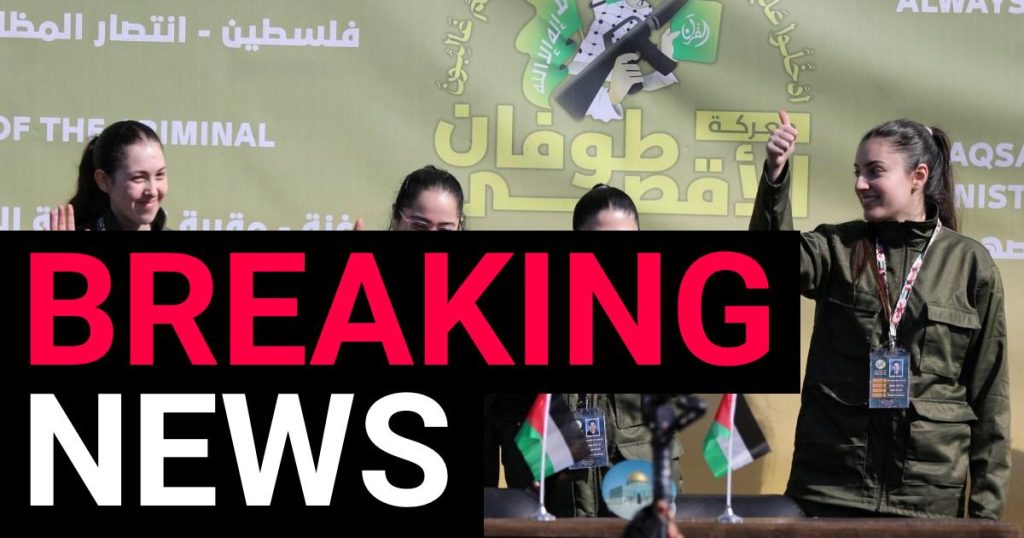The Joyous Return: Israeli Hostages Freed in Gaza Ceasefire
Amidst the ongoing conflict and tension in the Gaza Strip, a beacon of hope emerged as four female Israeli hostages were released by Hamas as part of a meticulously negotiated ceasefire agreement. The release sparked an outpouring of emotion in Israel, particularly in Tel Aviv’s Hostage Square, where thousands had gathered in anticipation. Tears of relief and cheers of jubilation filled the air as news of their crossing into Israeli territory spread like wildfire. The scene was a poignant mix of raw emotion and collective relief, capturing the profound impact of their captivity and the significance of their return. The freed hostages, Daniela Gilboa, Liri Elbag, Naama Levy, and Karina Ariev, were met with an outpouring of support and were immediately escorted by IDF and Shin Bet forces to a designated absorption point where emotional reunions with their families awaited. This poignant moment marked the culmination of weeks of anxious waiting and uncertainty for their loved ones.
A Reciprocal Gesture: Prisoner Exchange in the Gaza Conflict
The release of the Israeli hostages was not a unilateral act but part of a broader prisoner exchange agreement between Israel and Hamas. In return for the freedom of these four women, Israel agreed to release 200 Palestinian prisoners. This reciprocal gesture underscores the intricate nature of the negotiations and the delicate balance of power at play. While the exact identities of the released Palestinian prisoners remain undisclosed, this exchange represents a significant concession on both sides and highlights the complex human dimension of the conflict. The exchange also serves as a stark reminder of the thousands of Palestinians held in Israeli prisons, many on security grounds, and the ongoing debate surrounding their detention.
Hamas’s Role and the Evolving Ceasefire Dynamics
Hamas, the militant group controlling the Gaza Strip, played a central role in the hostage release, further solidifying their position in the ongoing conflict. The group’s involvement in the negotiations and their public display of the released hostages underlines their influence and control within the region. The ceasefire agreement, of which the hostage release is a crucial component, also stipulates the withdrawal of Israeli soldiers from key positions within Gaza. This strategic withdrawal is intended to facilitate the return of displaced Palestinians to their homes in the northern part of the Gaza Strip, signaling a potential easing of tensions and a step towards restoring some semblance of normalcy for the affected population.
The Human Cost of Conflict: A Deeper Look at the Hostages and Prisoners
The story of the four released Israeli hostages is just one facet of the broader human narrative of the Israeli-Palestinian conflict. While their release is a cause for celebration, it also brings to the forefront the plight of countless others impacted by the ongoing violence. The ceasefire agreement, while a positive step, does not erase the trauma and suffering experienced by both Israelis and Palestinians. Moreover, the prisoner exchange, while offering a glimmer of hope for some families, highlights the complex issue of detention and imprisonment in the context of the conflict. The continued presence of thousands of Palestinian prisoners in Israeli jails remains a contentious point, underscoring the deep-seated divisions and the need for sustained dialogue and reconciliation.
Gazans Celebrate Hostage Release, Awaiting Further Developments
The release of the hostages was met with jubilation not only in Israel but also within Gaza. Crowds gathered in Gaza City’s Palestine Square, demonstrating a sense of shared relief and anticipation for further developments in the ceasefire agreement. The presence of Hamas gunmen and members of other militant groups at the gathering served as a reminder of the complex and often volatile political landscape in Gaza. The upcoming weeks are crucial as Hamas is expected to release further details about other hostages they intend to free, potentially paving the way for further prisoner exchanges and contributing to the overall de-escalation of tensions.
The Fragile Hope for Peace: Navigating the Complexities of the Ceasefire
The ceasefire agreement and the subsequent hostage release offer a fragile hope for a more peaceful future in the region. However, the underlying issues fueling the conflict remain unresolved, and the path forward is fraught with challenges. The agreement represents a delicate balance of interests and concessions from both sides, and its long-term success hinges on continued dialogue and a commitment to de-escalation. The human stories emerging from this conflict, including the joyous return of the Israeli hostages and the release of Palestinian prisoners, underscore the urgent need for a lasting solution that addresses the root causes of the conflict and ensures a more secure and hopeful future for all. The ceasefire is a crucial step, but it is just the beginning of a long and arduous journey towards peace.


